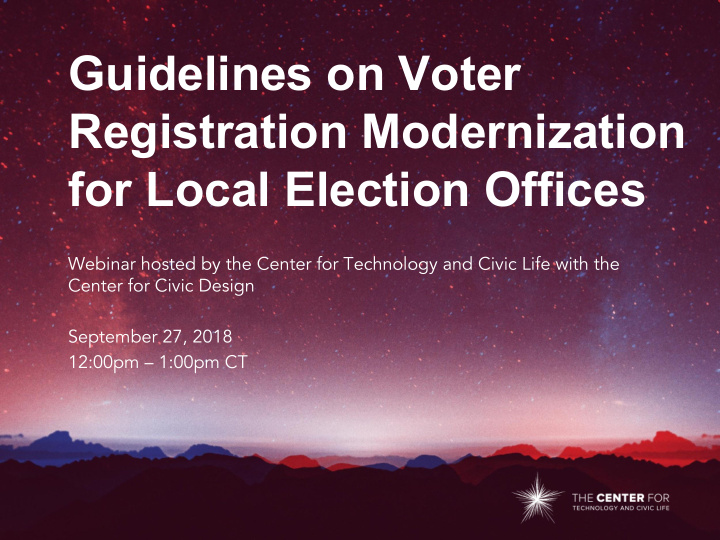



Guidelines on Voter Registration Modernization for Local Election Offices Webinar hosted by the Center for Technology and Civic Life with the Center for Civic Design September 27, 2018 12:00pm – 1:00pm CT
What we’ll cover today • Quick background on CTCL, CCD, and the project • Different kinds of voter registration modernizations • Guidelines for local election officials at electiontools.org
Hello, there! Whitney May whitney@techandciviclife.org @whitneymaybe Whitney Quesenbery whitneyq@civicdesign.org @whitneyq Kurt Sampsel kurt@techandciviclife.org @kurt_sampsel
The Center for Civic Design Ensuring voter intent through design. Our goal is to make every interaction between government and citizens easy, effective, and pleasant. @CivicDesign www.civicdesign.org
The Center for Technology & Civic Life Using technology to improve how local government and communities interact. Our goal is to make it as easy as possible to find official election information online. @HelloCTCL www.techandciviclife.org
How are states streamlining the voter registration process? VOTER REGISTRATION MODERNIZATIONS
What is voter registration modernization? Purposes of the National Voter Registration Act of 1993: • Increase the number of registered voters • Enhance voter participation • Protect election integrity • Ensure states maintain accurate voter rolls
What is Automatic Voter Registration? Qualified people who apply for or renew a driver’s license (or other government service) are automatically registered to vote, unless they decide to opt-out of voter registration.
Where is AVR approved?
What are important distinctions? Electronic data transfer and AVR are often conflated but are not the same. Electronic data transfer is a standard feature of a modernized voter registration process. States using electronic data transfer have transitioned away from sharing voter registration data between agencies via paper forms and instead send data electronically on a regular basis. Automatic Voter Registration is a process for managing the electronic data transfer of voter registration data.
What about other voter registration modernizations? • Delaware implemented eSig, or e-signature in their DMVs in 2009. The average transaction time for voter registration at the Delaware DMV is 15 seconds. • Pennsylvania ’s recent tech upgrade allows the voter registration questions to be presented in 12 languages beyond English and Spanish. • Virginia adopted Delaware’s eSig and added additional features in 2016, the most notable being a real-time connection between the DMV and the state election office databases.
Modernization doesn’t come without challenges http://www.latimes.com/politics/la-pol-ca-dmv-voter-registration-error-20180905-story.html http://www.providencejournal.com/news/20180831/5000-ri-voter-records-caught-in-computer-glitc h
What research was involved with this project? TALKING WITH ELECTION EXPERTS
How did we gather information? https://www.techandciviclife.org/news/2018/5/31/voter-reg-workshop
Who else did we talk with?
What did we learn? • Local election officials have positive experiences with voter registration modernizations • Regarding data quality, there’s concern about sharing responsibility with other state agencies for voter registration • How the voter registration questions are asked makes a difference • We need a national resource to support local election officials as voter registration processes are updated
How can we share what we’ve learned? INTRODUCING A NEW TOOL IN THE ELECTION TOOLKIT
What’s the Election Toolkit? www.electiontools.org
Introducing the newest tool
How is the tool organized?
What should you expect when expecting voter registration modernization? 11 THINGS YOU SHOULD KNOW
1. Your office’s relationship with the state election office is critical.
2. Your office’s relationship with the DMV is important.
3. Your office’s work to review and verify digital voter records is ongoing.
4. Your office may experience temporary shifts in workload.
5. Transferring voter registration data electronically reduces shipping costs, data entry time, and errors.
6. Voter registration modernization isn’t perfect.
7. Pay attention to voters who may have different addresses with the DMV and the election office.
8. Most of the public already believes that their voter registration is transferred between the DMV and the election office.
9. Voter registration modernization reduces lines and frustrations on Election Day.
10. How the voter registration questions are phrased and sequenced impacts the process.
11. Over time, we can spend fewer resources on registration and more resources on education.
Want to learn about updates to the Toolkit?
What we covered today • Background on CTCL, CCD, and the project • Different kinds of voter registration modernizations • Guidelines for local election officials at electiontools.org
What are your comments or questions? GROUP DISCUSSION
Group discussion questions What resonated with you today? What did we cover that you have questions about? Is there something we didn’t discuss today that you’re curious about?
Thank you. Whitney May whitney@techandciviclife.org Whitney Quesenbery whitneyq@civicdesign.org Kurt Sampsel kurt@techandciviclife.org
Recommend
More recommend